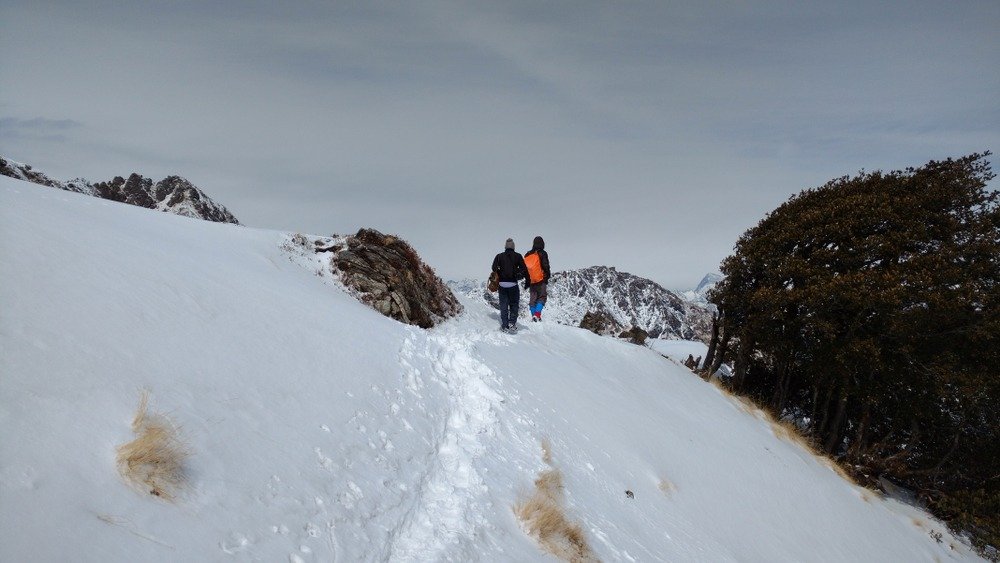When I first heard about the Kuari Pass Trek in December, I wasn’t sure what to expect. I had done summer treks before, but a Himalayan winter trek sounded both thrilling and intimidating. However, once I stepped onto the snow-laden trails of Kuari Pass, I realized it’s one of those rare treks that combine adventure, serenity, and raw natural beauty in perfect balance.
December transforms Kuari Pass into a dreamscape — imagine walking through forests covered in snow, every tree branch shining like glass under the morning sun, and the mighty Nanda Devi towering in the background like a silent guardian. This trek isn’t just a journey through mountains; it’s a journey through peace itself.
If you’re planning to experience the Kuari Pass Trek in December, here’s everything I learned firsthand — from the weather and trail conditions to how to prepare, what to expect, and how to make the most of your adventure.
Weather in December
December marks the true arrival of winter in the Garhwal Himalayas. Temperatures hover between -5°C to 10°C, and snowfall becomes frequent after mid-December. The air feels crisp and biting, especially early in the morning and after sunset.
During the day, the sunlight feels warm when you’re walking, but once the wind picks up, you’ll need to layer up quickly. Nights at Khullara and Tali campsites are particularly cold, and you’ll often wake up to find your tent zipper frozen shut.
However, the weather in December also brings unmatched clarity. The skies are crystal clear, revealing endless Himalayan ranges without a single cloud in sight. You can easily spot Nanda Devi, Dronagiri, Kamet, Chaukhamba, and several other towering peaks — all draped in dazzling white.
If you want snow but don’t want to trek through waist-deep drifts, aim for early to mid-December. If you’re comfortable with deeper snow and slightly tougher trails, late December is pure magic.
Pro tip: Avoid cotton clothing. Once wet, it stays cold. Go for synthetic or wool-based layers. Keep two pairs of gloves — one light fleece pair and one waterproof pair — to manage both warmth and dexterity.
The Magical Views of Kuari Pass
The views from the Kuari Pass Trek are among the best in India, especially in winter. As you trek upward from Auli, the scenery opens up dramatically. Dense oak and rhododendron forests give way to meadows covered in snow, and the skyline is constantly dominated by majestic peaks.
Standing at the top of Kuari Pass (12,516 ft), you feel completely surrounded by giants — Nanda Devi, Kamet, Chaukhamba, Trishul, Hathi-Ghoda, and Dronagiri stand tall like a grand Himalayan amphitheater. The entire range glows in hues of gold and pink at sunrise, a sight that genuinely makes you forget the cold.
What makes December special is how the snow changes the entire landscape. The forests turn silent except for the crunch of your boots, the streams freeze into crystal sculptures, and the mountains seem closer than ever. Even ordinary moments — like sipping hot tea at camp or watching smoke curl up from a kitchen tent — feel cinematic.
At Tali campsite, I remember waking up early, brushing off frost from my tent, and watching the first light touch Nanda Devi. That view alone made every cold night and steep climb worth it.
Trail Experience in December
The Kuari Pass trail starts from Joshimath, a small but lively town in Uttarakhand. From there, you typically drive to Dhak Village or Auli, the starting points of the trek. December adds an extra layer of adventure to this journey because snow changes the texture of every trail segment.
The first stretch from Auli to Gulling is a gentle climb through oak forests. The trail gradually becomes steeper as you move toward Khullara campsite, where snow usually starts covering the ground by mid-December. From Khullara to the Kuari Pass top, the trail gets challenging but exciting — narrow ridges, frozen patches, and sweeping mountain views keep you motivated.
If you’ve never trekked in snow before, walking with microspikes or gaiters can make a big difference. Trekking poles also help maintain balance, especially on the descent.
Evenings at camp are the coziest part of the day. We’d gather around, sip soup, share stories, and watch the stars come alive. The sky at 10,000+ ft in December is something you have to see to believe — millions of stars, crisp constellations, and occasionally even a shooting star cutting across the frozen night.
Preparation and Fitness Tips
Kuari Pass is classified as a moderate trek, but in December, snow adds to the difficulty. You don’t need to be an athlete, but you do need to prepare.
Here’s what worked for me:
-
Cardio: I jogged or cycled for 30–40 minutes, five times a week, for a month before the trek.
-
Stair climbs: Great for building leg strength. Try doing 4–5 sets of 20 stairs daily.
-
Breathing exercises: Deep breathing and short hikes with a backpack help simulate high-altitude conditions.
Also, pack light but smart. Keep your backpack under 8–9 kg and carry:
-
3–4 layers (thermal, fleece, jacket)
-
Warm gloves and socks
-
Sunglasses (snow glare can be harsh)
-
Sunscreen and lip balm
-
Trekking poles
-
A power bank and headlamp
Don’t forget altitude acclimatization — it’s essential. Spend a day in Joshimath or Auli before starting the trek. Drink plenty of water and eat light, warm meals.
Tips for Trekking Kuari Pass in December
-
Start early each day. Days are shorter in winter, and you’ll want to reach camp before 3 PM.
-
Hydrate even in cold weather. Dehydration causes fatigue faster in high altitudes.
-
Keep electronics close to your body. Batteries drain quickly in the cold.
-
Use double socks at night. Keeps your feet warm and avoids frostbite.
-
Carry a thermos. Warm water helps a lot during long snowy stretches.
-
Follow your guide’s lead. Trails can get covered with snow overnight.
When I did the kuari pass trekking, I went with The Searching Souls, and it was one of the best decisions I made. They’re not just organized — their approach to sustainable trekking and safety is solid. They make sure everyone acclimatizes properly, teach mountain etiquette, and even clean trails as they go. It felt like traveling with professionals who genuinely care, not a commercial trip.
Local Culture & Highlights
Joshimath and Auli are more than just starting points — they have their own charm. Joshimath is a spiritual town, home to Adi Shankaracharya’s math, and Auli is a skiing paradise in winter. If you have an extra day, take the ropeway from Joshimath to Auli — the view is spectacular.
The locals are warm and welcoming, always ready to share stories about their villages or offer a cup of chai. In December, when everything is blanketed in snow, the simplicity of their lifestyle feels even more inspiring.
Is Kuari Pass in December for You?
If you love snow, quiet trails, and mountain views that take your breath away — absolutely yes. But if you’re expecting comfort and warm weather, this isn’t your trek. December demands patience, endurance, and a good attitude toward the cold.



Leave a Reply